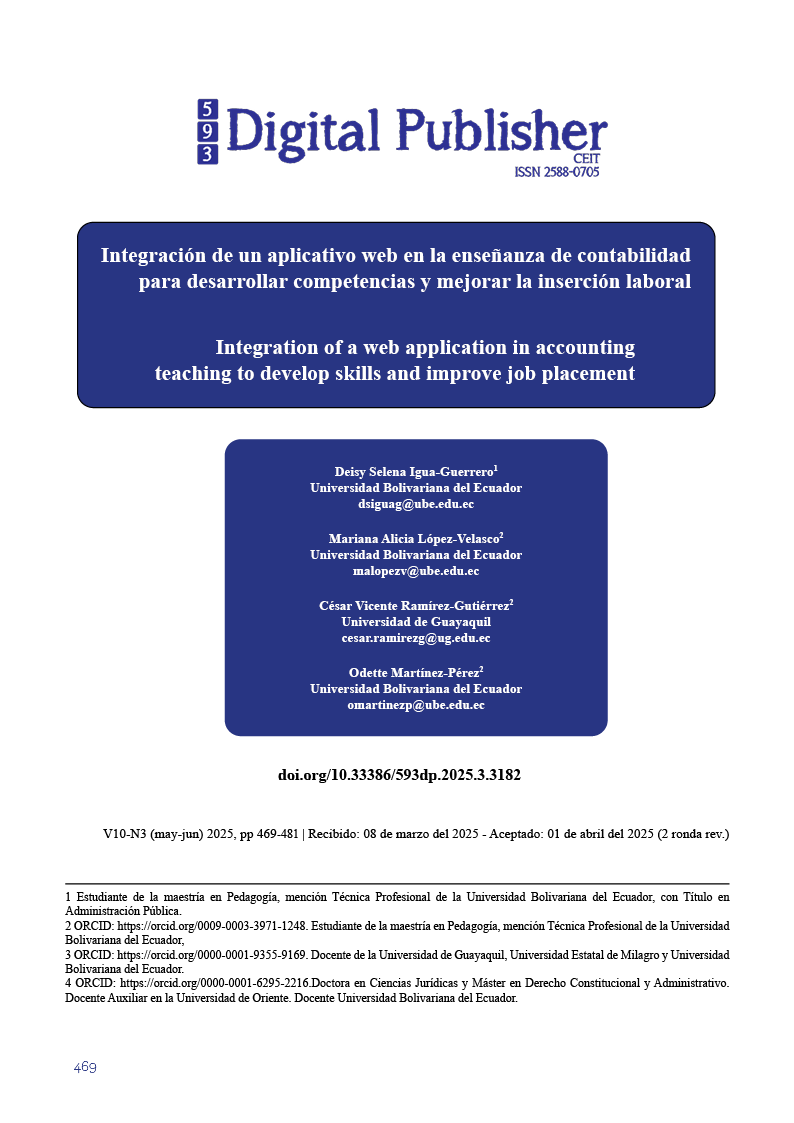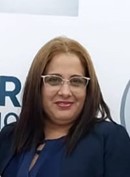Integración de un aplicativo web en la enseñanza de contabilidad para desarrollar competencias y mejorar la inserción laboral
Contenido principal del artículo
Resumen
Este trabajo investiga el proceso de enseñanza-aprendizaje y el uso de herramientas digitales en la enseñanza de la contabilidad a los estudiantes del Instituto Superior Tecnológico “Vicente Fierro”, ubicado en la ciudad de Tulcán, provincia del Carchi, Ecuador. Se enfoca en la integración de un aplicativo web contable, basado en una investigación mixta y de campo, recopilando datos cualitativos y cuantitativos para realizar el análisis numérico. El estudio inicia con un diagnóstico sobre el uso de herramientas digitales, identificando que actualmente en el Instituto se trabaja con Excel. Posteriormente, se capacita a los estudiantes en el manejo del software contable mediante casos reales. Se analiza la problemática del uso de las TIC, seguido de un estudio estadístico, y se evalúa el manejo del aplicativo. En nuestro estudio, la muestra está conformada por 33 estudiantes encuestados en relación con la integración de tecnologías en la enseñanza de contabilidad. El objetivo es demostrar que este enfoque fortalece la educación y formación técnica y profesional (EFTP), ayudando a los estudiantes a familiarizarse con tecnologías esenciales para su vida profesional aumentando, aumentando su confianza en sus competencias y experiencias educativas. De esta manera, podrán responder requerimientos empresariales y facilita su inserción laboral.
Descargas
Detalles del artículo

Esta obra está bajo una licencia internacional Creative Commons Atribución-NoComercial-CompartirIgual 4.0.
1. Derechos de autor
Las obras que se publican en 593 Digital Publisher CEIT están sujetas a los siguientes términos:
1.1. 593 Digital Publisher CEIT, conserva los derechos patrimoniales (copyright) de las obras publicadas, favorece y permite la reutilización de las mismas bajo la licencia Licencia Creative Commons 4.0 de Reconocimiento-NoComercial-CompartirIgual 4.0, por lo cual se pueden copiar, usar, difundir, transmitir y exponer públicamente, siempre que:
1.1.a. Se cite la autoría y fuente original de su publicación (revista, editorial, URL).
1.1.b. No se usen para fines comerciales u onerosos.
1.1.c. Se mencione la existencia y especificaciones de esta licencia de uso.
Citas
Barbudo, A. A., Zapata González, A., & Reyes Cabrera, W. R. (2021). COMPETENCIAS DIGITALES EN ESTUDIANTES DE EDUCACIÓN SECUNDARIA. UNA REVISIÓN SISTEMÁTICA. Etic@net. Revista Científica Electrónica de Educación y Comunicación En La Sociedad Del Conocimiento, 21(2), 366–392. https://doi.org/10.30827/eticanet.v21i2.20959
Blear. (17 de septiembre de 2023). Principios contables: una guía completa para entender su importancia y aplicación en la contabilidad - Blearning. Obtenido de https://blearning.es/principios-contables/
Caballero, J. E. A. P., Zuñiga, L. M. R., Zapata, C. A. V., De la Cruz, J. R. R., & De Ruiz, K. F. C. (2022). Herramientas digitales más eficaces en el proceso enseñanza-aprendizaje. Horizontes. Revista de Investigación En Ciencias de La Educación, 6(23), 669–678. https://doi.org/10.33996/revistahorizontes.v6i23.367
Claro, M., & Castro, C. (2023). Tecnologías digitales Foro Regional de Política Educativa.
DORA. (2024). Software contable con Facturación Electrónica #1 de Ecuador. Obtenido de https://www.dora.ec/sistema-contable
Freire, Paulo. (1997). Pedagogía da autonomía : saberes necesarios à prática educativa. Paz e Terra.
Hernández, R. (2014). 529184279-Metodologia-de-La-Investigacion-Hernandez-Sampieri. Mc Graw Hill Education, 6.
Mantilla, M. F., Tobar, G., Arias, M., & Ríos, G. (2018). Competencias del contador-auditor en el perfil de egreso. Caso Universidad Técnica de Ambato, Ecuador. Actualidad Contable Faces, 21(37), 90–117. https://www.redalyc.org/pdf/257/Resumenes/Abstract_25755483005_2.pdf
Mite-Quinto, G., Vargas-Cercado, J., Franco-Solis, O., & Maliza-Cruz, W. (2024). Uso de un Software Contable en el proceso de Enseñanza del Módulo de Paquete Contable. 593 Digital Publisher CEIT, 9(2), 916–940. https://doi.org/10.33386/593dp.2024.2.2389
Ortega, C. (29 de julio de 2022). https://www.questionpro.com/blog/es/investigacion-mixta/. Obtenido de https://www.questionpro.com/blog/es/investigacion-mixta/.
Padilla, G. M. R., Caicedo, C. C. R., Rodríguez, V. G. G., & Cornejo, M. A. (2023). Herramientas digitales en el proceso enseñanza-aprendizaje mediante revisión bibliográfica Digital tools in the teaching-learning process through bibliographic review Ferramentas digitais no processo de ensino-aprendizagem por meio de revisão bibliográfica Ciencias de la Educación Artículo de Investigación. 85, 313–344. https://doi.org/10.23857/pc.v8i10.6127
Salazar, C. T. (2018). Estrategia de enseñanza y aprendizaje para la docencia universal, experiencias desde el aula. Colima: Universidad de colima publicaciones
Tello, I., Tul, L., Vaca, A., & Villavicencio, N. (2018). CONTABILIDAD GENERAL.
Torres, G. P., Arias, E. P., Castañeda, D. T., & Castillo, N. A. (2023). Sistemas contables computarizados.
Vizcaino, A., & Becerra, G. (2019). Uso de un software contable como estrategia en el proceso de enseñanza de la asignatura de contabilidad. Revista Espacios, 40, 1–17.
Warren, C. S. ., Reeve, J. M. ., & Duchac, J. E. . (2016). Financial accounting. Cengage Learning.
Zapata, P. (2017). Contabilidad General con base a normativa de NIIF. Colombia: Alfaomega Colombia S.A.





